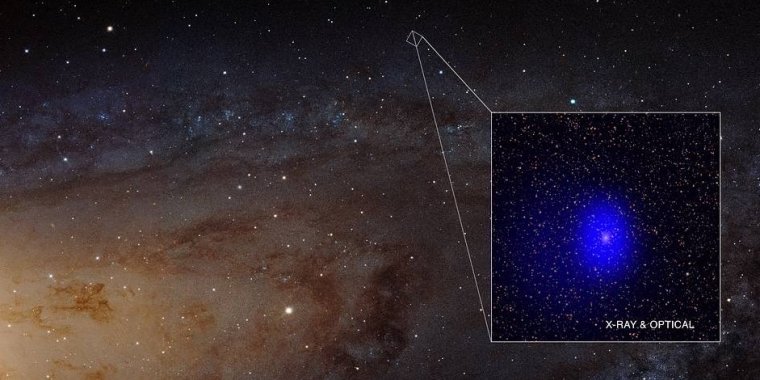| News / Space News |
Giant Black Hole Pair Photobombs Andromeda Galaxy
A cosmic photobomb found as a background object in images of the nearby Andromeda galaxy has revealed what could be the most tightly coupled pair of supermassive black holes ever seen.

X-ray source J0045+41. Image credits: X-ray: NASA/CXC/University of Washington/T. Dorn-Wallenstein et al.; Optical: NASA, ESA, J. Dalcanton et. al. and R. Gendler
This unusual source, called LGGS J004527.30+413254.3 (J0045+41 for short), was seen in optical and X-ray images of Andromeda, also known as M31. Until recently, scientists thought J0045+41 was an object within M31, a large spiral galaxy located relatively nearby at a distance of about 2.5 million light-years from Earth.
The new data, however, revealed that J0045+41 was actually at a much greater distance, around 2.6 billion light years from Earth.
Even more intriguing than the large distance of J0045+41 is that it likely contains a pair of giant black holes in close orbit around each other. The estimated total mass for these two supermassive black holes is about two hundred million times the mass of our Sun.
Previously, a different team of astronomers had seen periodic variations in the optical light from J0045+41, and, believing it to be a member of M31, classified it as a pair of stars that orbited around each other about once every 80 days.
A spectrum from the Gemini-North telescope taken by the University of Washington team showed that J0045+41 must host at least one supermassive black hole and allowed the researchers to estimate the distance.
The spectrum also provided possible evidence that a second black hole was present in J0045+41 and moving at a different velocity from the first, as expected if the two black holes are orbiting each other.
The researchers estimate that the two putative black holes orbit each other with a separation of only a few hundred times the distance between the Earth and the Sun. This corresponds to less than one hundredth of a light year. By comparison, the nearest star to our Sun is about four light years away.
Such a system could be formed as a consequence of the merger, billions of years earlier, of two galaxies that each contained a supermassive black hole.
“We're unable to pinpoint exactly how much mass each of these black holes contains,” said co-author John Ruan, also of the University of Washington. “Depending on that, we think this pair will collide and merge into one black hole in as little as 350 years or as much as 360,000 years.” (NASA)
YOU MAY ALSO LIKE



